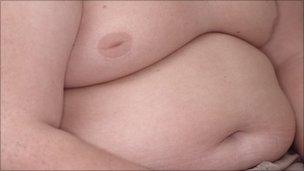Doubts emerge over heart risk to 'apple shape'
- Published

Previous research argued that being overweight and 'apple shaped' greatly increased the risk of heart disease
Doubts have been raised over the idea that being overweight and "apple shaped" increases heart attack risk.
A study in the Lancet, external found the risk of heart attack was not increased by fat being concentrated around the waist.
It contradicts previous work that found overweight people with "apple shaped" bodies were three times as likely to suffer heart attacks than those with more generally distributed fat.
But experts warned obesity was bad for the heart, no matter where the fat was.
The authors of the study say that obesity is still a major risk factor for heart disease, but they argue there is confusion about the best way to measure it.
One well known measure is the Body Mass Index (BMI) which relates weight to height.
Apples and pears
But previous research had also suggested that people with fat deposits in the middle of their body - known as an "apple shape" - were at much greater risk.
This method uses the "waist-to-hip" ratio and compares the distance around the hips and waist to measure what is known as central obesity.
It can tell if someone is "apple shaped - with a bulging middle - or "pear shaped", with a narrower waist and fatter hips and bottom.
Others have suggested concentrating on a measurement of the waist alone.
But this new study, which looked at 220,000 people over almost 10 years, found that all three measures indicated risk of heart attack or stroke.
The study was led by Professor John Danesh from Cambridge University and concluded that none of the measures on their own improved the prediction of heart disease, especially when doctors could also assess other warning signs like blood pressure and cholesterol levels.
Writing in the Lancet, Professor Danesh said: "Whether assessed singly or in combination, body-mass index, waist circumference, and waist-to-hip ratio do not improve prediction of first-onset cardiovascular disease when additional information exists on blood pressure, history of diabetes, and cholesterol measures."
The study was funded by the Medical Research Council (MRC) and the British Heart Foundation (BHF).
Obesity is still bad for you
The BHF's associate medical director Dr Mike Knapton said it was clear that no matter how you measure it, obesity is bad for your heart.
"This study suggests that measuring your waist is no better than calculating your BMI but it's not time to throw away the tape measure just yet.
"We tend to underestimate our body shape and size, so measuring our waist or checking our BMI are both quick and easy ways we can check our health at home.
"We should also remember there are other heart risk factors we need to think about too, such as blood pressure, cholesterol, diabetes and smoking.
"Anyone over 40 who's worried about their waist measurement or BMI should ask at their GP surgery for a heart health assessment, which will take into account all cardiovascular risk factors and provide practical advice on how you can reduce your risk."
Professor Stephen Holgate of the MRC said the main worry about obesity was that it led to other illnesses.
"Around three-fifths of type 2 diabetes and one-fifth of heart disease cases are attributable to excess body fat. Six cancers are also linked to obesity.
"The percentage of UK adults who are obese has increased by 50% in the last decade, and obesity in children continues to grow at an alarming rate."
- Published25 February 2011
- Published24 February 2011
- Published14 July 2010